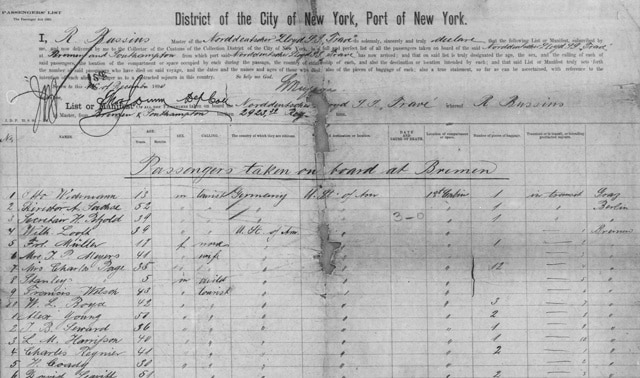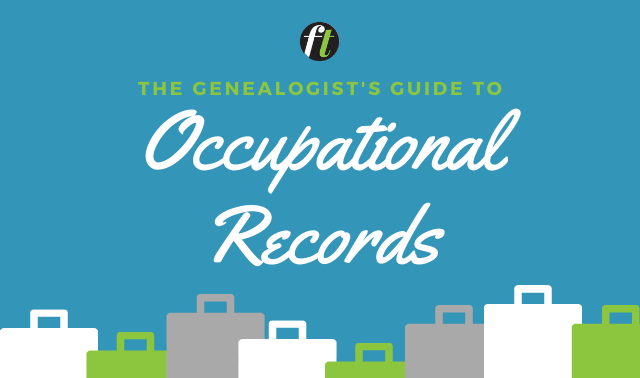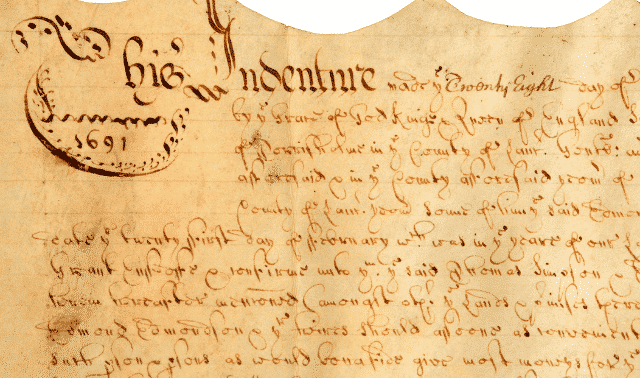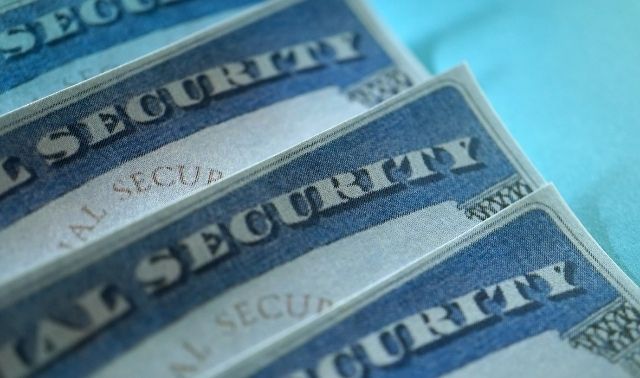Identifying ancestors’ occupations is an important part of thorough genealogy research. Learning about the work an ancestor performed can give a better idea of what their daily life was like since this was how they spent much of their time. Occupations also helped determine a person’s socio-economic status. Most importantly, an ancestor’s occupation can be a distinguishing characteristic that makes them easier to locate in record collections. This is particularly helpful if they had a common name, or if they lived in a heavily populated urban area.
Don’t assume that only the men in a family had careers. Women often worked before they were married. Some entered the workforce if they were widowed or divorced at a young age. Children, both boys and girls, may have worked to help support their family.
Even if you find an ancestor’s occupation in one record, continue to check other sources as well. Your ancestor may have changed careers at some point in their life. These occupations can be uncovered in a variety of sources. Below are 12 different sources that often reveal an ancestor’s occupation, some of which may also provide other fascinating details about the work they performed.
1. Federal Census Records
The 1850 Census was the first to record the occupations of working individuals in the United States. Later census records continued to include occupations, and they provided even more details about employment. The 1880 census, for example, asks how many months a person was unemployed in the last year. A column asking for a worker’s specific industry was added in 1910. This census also asked if workers were employees, employers, or if they were working on their own account.
Determining the industry in which someone worked is important because this will potentially lead to more record sources. For example, was one of your ancestors employed by the railroad industry? The National Archives at Atlanta holds the records for the Railroad Retirement Board.
The 1940 census is an especially rich resource for finding employment data. A series of questions were asked about employment status, including: workers’ involvement in New Deal programs such as the Civilian Conservation Corps (CCC), the number of hours worked each week, the duration of unemployment, if any, the number of weeks worked in 1939, and the amount of wages earned in 1939.
Ancestry.com provides access to surviving federal census records, and also offers a new tour feature. This feature walks users through details found in census records, and even provides additional information, such as their annual income in the 1940 census adjusted for inflation.
2. State Census Records
Most states conducted a state census at least once in their history, and many states completed numerous censuses. The only states that never conducted a census are Connecticut, Idaho, Kentucky, Montana, New Hampshire, Ohio, Pennsylvania, Vermont and West Virginia.
Even in the states that did hold censuses, not all of these records survive, and those that do will contain varying information which may or may not include respondents’ occupations. New York State, for example, conducted a total of 11 statewide censuses between 1790 and 1925. The records from 1855 and later include the occupations of residents. Ancestry.com and FamilySearch both hold some of these state census records, while others may only be available at the state archives. For a complete list of state censuses, visit www.census.gov/history/www/genealogy/other_resources/state_censuses.html.
3. City Directories
A typical listing in a city directory includes the name of the head of a household, their address, occupation, and in many cases, the specific company where they were employed. Identifying the company where they worked can provide an additional avenue for your research. For example, a local historical society may have information about the company, which can offer more insight into the type of work your ancestor performed. If your ancestor was a business owner, a city directory may also include an advertisement for their business.
Ancestry.com’s U.S., City Directories, 1822-1995 database contains more than 1.3 billion records. You can search for directories in a specific location by navigating to the card catalog and selecting Directories & Member Lists. Next, click City & Area Directories, then filter the results by location. You can then search for a name in each directory. The listings will be alphabetized, which makes it easy to search the pages yourself if you don’t receive the search results you’re expecting. If Ancestry.com’s database is missing the location or time period you’re searching for, try contacting the local city or county historical society where your ancestor lived. They may have physical copies of directories that can be searched.
4. Newspaper Archives
There are seemingly endless possibilities to what may be discovered about an ancestor in newspaper archives, and information about their occupation is no exception. You could learn about an injury they sustained at work, their involvement in a local chapter of a labor union, or find an announcement of their retirement. Business owners often advertised their services in newspapers or purchased a classified ad when they were hiring. If your ancestor worked for a school district or was a government employee, the local newspaper may have published an item about their hiring, and possibly even the salary they earned.
Marriage announcements and obituaries often mention where the subject was employed, and sometimes the duration of their employment. If you have identified the specific company where an ancestor worked, you can also research the company in newspaper archives.
5. Free Historic Newspapers Online
The availability of a birth certificate and the information it contains will depend on the time period and the state where the birth occurred, but a birth certificate could contain the occupations of the child’s parents. Some states began issuing birth and death certificates in the late 19th century, but others didn’t begin until well into the 20th century.
Ancestry.com holds some states’ birth records and indexes up to a certain time period, but if you’re unable to find what you’re looking for online, you may need to contact the state agency that holds the vital records where the birth occurred. The names of these agencies vary by state, but it could be the state’s Department of Health, or Office of Vital Statistics. If you know the specific county or town where the birth occurred, try contacting the county or town clerk first. They may be able to provide you with the record much more quickly than the state office. However, due to privacy concerns, there will likely be restrictions preventing records from being made available to the public until a certain amount of time has passed since the birth.
6. Death Certificates
The availability of death certificates is similar to birth certificates. If a decedent was still working at the time of their death, their occupation may be listed on their death certificate, or it may only say “Retired” if they were no longer working. Be sure to look closely at the cause of death as well. If a person died because of an accident at work, this could be noted. The location of death certificates is similar to those of birth certificates. If the records are not available online, check with the appropriate state agency, county, or city clerk. Access to these records may also be limited for a certain period of time.
7. Marriage Records
Civil marriage records, such as an application for a marriage license or a marriage registration, are more likely to provide occupational information than church marriage records. Earlier records may only have a field for the groom’s occupation, while later records from the 20th century may ask for the occupations of both the bride and groom. Ancestry.com and FamilySearch both contain numerous databases that include marriage records, but many of these records can only be found offline. If a record cannot be found in an online database, check with the courthouse or the historical society in the county where the marriage may have taken place.
8. Military Records
The records available for a veteran ancestor will vary a great deal depending on the conflict in which they served. A pension application is likely available for Revolutionary War veterans who were still alive in 1818, when additional pension legislation was passed. To obtain a pension, the former soldiers needed to provide testimony in court about their military service and demonstrate that they were financially in need. The veteran’s occupation, or former occupation if they were no longer able to work, may be included in their testimony. Access to these records can be obtained with a subscription to Fold3.
Enlistment records for those who served in the Union Army during the Civil War noted the soldier’s occupation. Union veterans’ pension records can also contain a wealth of information about the soldier. These pension files can be purchased online from the National Archives. Select the Order Online option for Military Pension/Bounty Land Warrant Applications, followed by Federal Military Pension Application – Civil War and Later Complete File (NATF 85D) on the next screen. You will need to set up an account to order records, and you can order an electronic copy or paper copies by mail.
Confederate veterans may have been eligible to receive a pension from the state where they lived. The information contained in these records will vary by state. For information on where to locate these records in each state that offered these pensions, visit https://www.archives.gov/research/military/civil-war/confederate-pension-records.
Ancestry.com’s database U.S., Army, Register of Enlistments, 1798-1914 contains records of enlistments in the regular army. These records include the enlistee’s occupation. For more information on these records and to search the collection, visit https://www.ancestry.com/search/collections/1198/.
9. Draft Registrations
Even if your ancestor didn’t serve in the military, they may have been included in a draft registration if they were in the appropriate age range during a military conflict. During the Civil War, men between the ages of 20 and 45 were required to register for the draft, with some exceptions. These drafts began in 1863 and continued until 1865. Registrants were asked to provide their occupation, among other information.
The United States held three draft registrations in 1917-1918 during World War I. These drafts required men between the ages of 18-45 to register. Occupation and employer were included on the registration form. Men in this age group were also required to register during multiple drafts held during World War II. In 1942, men between the ages of 45-64 who were not already in the military were also required to register. These draft records ask for information about the registrant’s employer.
10. Family Collections and Interviews
It’s important for genealogy researchers to be talking to their older family members about what they know about the family’s history. Asking about ancestors’ occupations should be one topic of conversation. If you have a relative with a collection of family history memorabilia, ask if they have any items related to a family member’s job. You never know what treasures you could stumble upon in an old trunk or in someone’s attic: photos of an ancestor at work, an invitation to a retirement party, small tools used while on the job, personal letters or journals that describe the writer’s job. You could find a business owner’s ledger that contains a list of business transactions and the cost of their services. These are just a few of the many exciting possibilities!
11. Wills
An individual’s will may or may not clearly identify their occupation. However, even if their occupation is not explicitly named in the document, there may be clues about their occupation in other documents that are generated during the probate process. For example, an inventory of the deceased person’s estate is usually taken to determine its total value. Their assets would be listed, which could include items relating to their profession. A farmer, for example, would likely possess a significant number of livestock. A carpenter would probably own numerous woodworking tools necessary in carrying out their job. FamilySearch has a large collection of wills, however many are not indexed. Wills are often kept at the courthouse of the county where the deceased person last lived.
12. Ship Passenger Lists
If you’re fortunate enough to locate an immigrant ancestor’s name on a passenger list, you may also find their occupation listed next to their name. The information contained on a passenger list depends largely on the time period in which it was created. Before 1820, there were few regulations regarding record keeping on ships. As a result, records were inconsistent and few lists now survive. The Steerage Act of 1819 required record keeping aboard ships regarding passengers who were arriving from foreign ports. Surviving records from the time period of 1820-1891 are not as detailed as later records, but they often include passengers’ occupations.
If you are searching for an ancestor who emigrated in 1891 or later, chances are quite good of locating records documenting their arrival in the United States. With the Immigration act of 1891, the federal government assumed control over immigration and standardized the process with more stringent record keeping. Forms that were required to be completed continued to include occupational data of incoming immigrants, but other details were added as well.
Related Reads
A version of this article appeared in the Jan/Feb 2022 issue of Family Tree Magazine. Last updated: January 2025









